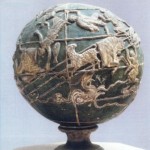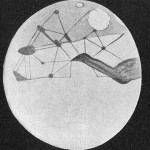Tue, 09/15/2015 - 7:14pm

The selection of The Martian for Somerville Reads raises the question, "Why Mars?" No one would ever write a book called The Venusian or The Plutoniac. But the words "Martian" or "Mars" command attention. And they long have. But why? What is it about this planet that has fascinated humanity for so long? A partial explanation is that Mars is distinctive-looking. The planets we can see without telescopes look like more or less white stars. Mars, on the other hand, is a striking reddish color.  Furthermore, every couple of years it moves relatively close to Earth and becomes much easier to see with the naked eye. Egyptian astronomers had identified it and recorded its movements as long ago as 1534 BCE.
Other ancient cultures took note of it as well. The Babylonians named it "Nergal," after their god of inflicted death, probably due to its blood-like color. The Greeks and
Furthermore, every couple of years it moves relatively close to Earth and becomes much easier to see with the naked eye. Egyptian astronomers had identified it and recorded its movements as long ago as 1534 BCE.
Other ancient cultures took note of it as well. The Babylonians named it "Nergal," after their god of inflicted death, probably due to its blood-like color. The Greeks and  Romans also both named it after their god of war (Ares and Mars). In China, Japan and Korea, Mars was referred to as "the fire star." The ancient Hebrews drew a more interesting association from its color, and named the planet "Ma'adim," "the one who blushes."
In modern times Mars became a source of fascination for another reason. In 1877 the Italian astronomer Giovanni Schiaparelli saw what he thought were long straight lines on the surface , and included them in the map he created of the planet. He called them canali, Italian for "grooves." The word was commonly mistranslated into English as "canals." The poor translation fueled speculation that the red planet was home to intelligent life.
The idea that there might be intelligent beings on Mars had some thinking, "How can we communicate with them?" And many people, in utter seriousness, suggested the most hare-brained ideas. Chicagoan E. Ellsworth Carey opined that a level section of land five miles in diameter be covered with a black substance and then "gas jets or electric arcs" be placed all over it about three feet apart. When the rotation of the Earth brought the side of the planet where this land was located to face Mars, someone controlling all these light sources would flash signals in Morse Code. The assumption being Martians could read Morse Code. The Boston Globe's editorial position on the idea was "If the people of that planet can read good Morse, it will work, but it will cost a heap."
In the 1890s former businessman and diplomat Percival Lowell took up an interest in astronomy and the idea that there were canals on
Romans also both named it after their god of war (Ares and Mars). In China, Japan and Korea, Mars was referred to as "the fire star." The ancient Hebrews drew a more interesting association from its color, and named the planet "Ma'adim," "the one who blushes."
In modern times Mars became a source of fascination for another reason. In 1877 the Italian astronomer Giovanni Schiaparelli saw what he thought were long straight lines on the surface , and included them in the map he created of the planet. He called them canali, Italian for "grooves." The word was commonly mistranslated into English as "canals." The poor translation fueled speculation that the red planet was home to intelligent life.
The idea that there might be intelligent beings on Mars had some thinking, "How can we communicate with them?" And many people, in utter seriousness, suggested the most hare-brained ideas. Chicagoan E. Ellsworth Carey opined that a level section of land five miles in diameter be covered with a black substance and then "gas jets or electric arcs" be placed all over it about three feet apart. When the rotation of the Earth brought the side of the planet where this land was located to face Mars, someone controlling all these light sources would flash signals in Morse Code. The assumption being Martians could read Morse Code. The Boston Globe's editorial position on the idea was "If the people of that planet can read good Morse, it will work, but it will cost a heap."
In the 1890s former businessman and diplomat Percival Lowell took up an interest in astronomy and the idea that there were canals on  Mars. He founded the Lowell Observatory in Flagstaff, Arizona and moved there to study Mars and Venus. He drew diagrams of what he saw on the red planet's surface, and decided that the canals had been dug by a desperate dying civilization to bring water from the polar ice caps to its much dryer central regions. Lowell wrote three books expounding his ideas: Mars (1895), Mars and its Canals (1906) and Mars as the Abode of Life (1908). Lowell is believed to have done more than any other man to popularize the idea that there is intelligent life is on Mars.
More posts on Mars later....
Mars. He founded the Lowell Observatory in Flagstaff, Arizona and moved there to study Mars and Venus. He drew diagrams of what he saw on the red planet's surface, and decided that the canals had been dug by a desperate dying civilization to bring water from the polar ice caps to its much dryer central regions. Lowell wrote three books expounding his ideas: Mars (1895), Mars and its Canals (1906) and Mars as the Abode of Life (1908). Lowell is believed to have done more than any other man to popularize the idea that there is intelligent life is on Mars.
More posts on Mars later....
 Furthermore, every couple of years it moves relatively close to Earth and becomes much easier to see with the naked eye. Egyptian astronomers had identified it and recorded its movements as long ago as 1534 BCE.
Other ancient cultures took note of it as well. The Babylonians named it "Nergal," after their god of inflicted death, probably due to its blood-like color. The Greeks and
Furthermore, every couple of years it moves relatively close to Earth and becomes much easier to see with the naked eye. Egyptian astronomers had identified it and recorded its movements as long ago as 1534 BCE.
Other ancient cultures took note of it as well. The Babylonians named it "Nergal," after their god of inflicted death, probably due to its blood-like color. The Greeks and  Romans also both named it after their god of war (Ares and Mars). In China, Japan and Korea, Mars was referred to as "the fire star." The ancient Hebrews drew a more interesting association from its color, and named the planet "Ma'adim," "the one who blushes."
In modern times Mars became a source of fascination for another reason. In 1877 the Italian astronomer Giovanni Schiaparelli saw what he thought were long straight lines on the surface , and included them in the map he created of the planet. He called them canali, Italian for "grooves." The word was commonly mistranslated into English as "canals." The poor translation fueled speculation that the red planet was home to intelligent life.
The idea that there might be intelligent beings on Mars had some thinking, "How can we communicate with them?" And many people, in utter seriousness, suggested the most hare-brained ideas. Chicagoan E. Ellsworth Carey opined that a level section of land five miles in diameter be covered with a black substance and then "gas jets or electric arcs" be placed all over it about three feet apart. When the rotation of the Earth brought the side of the planet where this land was located to face Mars, someone controlling all these light sources would flash signals in Morse Code. The assumption being Martians could read Morse Code. The Boston Globe's editorial position on the idea was "If the people of that planet can read good Morse, it will work, but it will cost a heap."
In the 1890s former businessman and diplomat Percival Lowell took up an interest in astronomy and the idea that there were canals on
Romans also both named it after their god of war (Ares and Mars). In China, Japan and Korea, Mars was referred to as "the fire star." The ancient Hebrews drew a more interesting association from its color, and named the planet "Ma'adim," "the one who blushes."
In modern times Mars became a source of fascination for another reason. In 1877 the Italian astronomer Giovanni Schiaparelli saw what he thought were long straight lines on the surface , and included them in the map he created of the planet. He called them canali, Italian for "grooves." The word was commonly mistranslated into English as "canals." The poor translation fueled speculation that the red planet was home to intelligent life.
The idea that there might be intelligent beings on Mars had some thinking, "How can we communicate with them?" And many people, in utter seriousness, suggested the most hare-brained ideas. Chicagoan E. Ellsworth Carey opined that a level section of land five miles in diameter be covered with a black substance and then "gas jets or electric arcs" be placed all over it about three feet apart. When the rotation of the Earth brought the side of the planet where this land was located to face Mars, someone controlling all these light sources would flash signals in Morse Code. The assumption being Martians could read Morse Code. The Boston Globe's editorial position on the idea was "If the people of that planet can read good Morse, it will work, but it will cost a heap."
In the 1890s former businessman and diplomat Percival Lowell took up an interest in astronomy and the idea that there were canals on  Mars. He founded the Lowell Observatory in Flagstaff, Arizona and moved there to study Mars and Venus. He drew diagrams of what he saw on the red planet's surface, and decided that the canals had been dug by a desperate dying civilization to bring water from the polar ice caps to its much dryer central regions. Lowell wrote three books expounding his ideas: Mars (1895), Mars and its Canals (1906) and Mars as the Abode of Life (1908). Lowell is believed to have done more than any other man to popularize the idea that there is intelligent life is on Mars.
More posts on Mars later....
Mars. He founded the Lowell Observatory in Flagstaff, Arizona and moved there to study Mars and Venus. He drew diagrams of what he saw on the red planet's surface, and decided that the canals had been dug by a desperate dying civilization to bring water from the polar ice caps to its much dryer central regions. Lowell wrote three books expounding his ideas: Mars (1895), Mars and its Canals (1906) and Mars as the Abode of Life (1908). Lowell is believed to have done more than any other man to popularize the idea that there is intelligent life is on Mars.
More posts on Mars later....
Add new comment